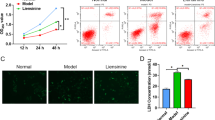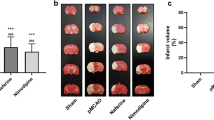Abstract
Ischemia/reperfusion (I/R) caused by ischemic stroke treatments leads to brain injury and its pathological mechanism is related to autophagy. The underlying mechanism of kaempferol on cerebral I/R injury needs to be explored. To establish I/R injury, we used a middle cerebral artery occlusion-reperfusion (MCAO) model in rats. MCAO rats were treated with the same amount of saline (I/R group); Treatment group rats were treated orally with kaempferol (50, 100, 200 mg/kg) for 7 days before surgery. After reperfusion for 24 h, the scores of neurological deficits and infarct volume in each group were evaluated. LC3, Beclin-1 p62, AMPK and mTOR protein expression levels were examined by TTC staining, immunofluorescence staining, qRT-PCR and western blotting assay. H&E and TTC staining showed that compared with model group, the infarction size of rats in kaempferol group was markedly reduced. Meanwhile, the results showed that kaempferol had a dose-dependent nerve function repairability. Nissl and TUNEL staining showed that kaempferol could reduce neuronal apoptosis and ameliorate neuronal impairment after I/R. Western blotting and qRT-PCR results showed that kaempferol could protect the brain from ischemia reperfusion by activating autophagy. In addition, add AMPK inhibitor, western blotting and immumohistochemical staining showed that kaempferol mediated AMPK/mTOR signal pathway in MCAO rats. Kaempferol could mediate the AMPK signal pathway to regulate autophagy and inhibit apoptosis to protect brain against I/R injury.






Similar content being viewed by others
Data Availability
Enquiries about data availability should be directed to the authors.
Abbreviations
- MCAO:
-
Middle cerebral artery occlusion-reperfusion
- I/R:
-
Ischemia/reperfusion
- MAPK:
-
Mitogen activated protein kinase
- TTC:
-
2,3,5-Triphenyltetrazolium chloride
- H&E:
-
Hematoxylin and eosin
- TUNEL:
-
Terminal deoxynucleotidyl-transferase-mediated dUTP nick end labeling
- PVDF:
-
Polyvinylidene difluoride
- BCA:
-
Bicinchoninic Acid
- Dor:
-
Dorsomorphin
- SDS-PAGE:
-
Sodium dodecyl sulfate–polyacrylamide gel electrophoresis
References
Wang H et al (2016) Global, regional, and national life expectancy, all-cause mortality, and cause-specific mortality for 249 causes of death, 1980–2015: a systematic analysis for the Global Burden of Disease Study 2015. Lancet 388(10053):1459–1544
Guo QQ et al (2020) ATM-CHK2-beclin 1 axis promotes autophagy to maintain ROS homeostasis under oxidative stress. EMBO J 39(10):e103111
Youn DH et al (2020) Extracellular mitochondrial dysfunction in cerebrospinal fluid of patients with delayed cerebral ischemia after aneurysmal subarachnoid hemorrhage. Neurocrit Care 33(2):422–428
Lai Y et al (2020) Restoration of L-OPA1 alleviates acute ischemic stroke injury in rats via inhibiting neuronal apoptosis and preserving mitochondrial function. Redox Biol 34:101503
Chen C et al (2020) Electroacupuncture pretreatment prevents ischemic stroke and inhibits Wnt signaling-mediated autophagy through the regulation of GSK-3β phosphorylation. Brain Res Bull 158:90–98
Wu B et al (2017) Succinate-induced neuronal mitochondrial fission and hexokinase II malfunction in ischemic stroke: therapeutical effects of kaempferol. Biochim Biophys Acta Mol Basis Dis 1863(9):2307–2318
Mishra SK et al (2020) Emerging roles for human glycolipid transfer protein superfamily members in the regulation of autophagy, inflammation, and cell death. Prog Lipid Res 78:101031
Lin Z et al (2020) RNA m(6) a methylation regulates sorafenib resistance in liver cancer through FOXO3-mediated autophagy. EMBO J 39(12):e103181
Wu D, Zhang K, Hu P (2019) The role of autophagy in acute myocardial infarction. Front Pharmacol 10:551
Wang M et al (2019) Homocysteine enhances neural stem cell autophagy in in vivo and in vitro model of ischemic stroke. Cell Death Dis 10(8):561
Mo Y, Sun YY, Liu KY (2020) Autophagy and inflammation in ischemic stroke. Neural Regen Res 15(8):1388–1396
Zeng C et al (2016) Crocin-elicited autophagy rescues myocardial ischemia/reperfusion injury via paradoxical mechanisms. Am J Chin Med 44(3):515–530
Guo Z et al (2014) A combination of four active compounds alleviates cerebral ischemia-reperfusion injury in correlation with inhibition of autophagy and modulation of AMPK/mTOR and JNK pathways. J Neurosci Res 92(10):1295–1306
Lagoa R et al (2009) Kaempferol protects against rat striatal degeneration induced by 3-nitropropionic acid. J Neurochem 111(2):473–487
Suchal K et al (2017) Molecular pathways involved in the amelioration of myocardial injury in diabetic rats by kaempferol. Int J Mol Sci 18(5):1001
Li WH et al (2019) Kaempferol attenuates neuroinflammation and blood brain barrier dysfunction to improve neurological deficits in cerebral ischemia/reperfusion rats. Brain Res 1722:146361
Zhang K, Zhang Q (2019) ALK5 signaling pathway mediates neurogenesis and functional recovery after cerebral ischemia/reperfusion in rats via Gadd45b. Cell Death Dis 10(5):360
Longa EZ et al (1989) Reversible middle cerebral artery occlusion without craniectomy in rats. Stroke 20(1):84–91
Guang HM, Du GH (2006) Protections of pinocembrin on brain mitochondria contribute to cognitive improvement in chronic cerebral hypoperfused rats. Eur J Pharmacol 542(1–3):77–83
Gao M et al (2008) Acute neurovascular unit protective action of pinocembrin against permanent cerebral ischemia in rats. J Asian Nat Prod Res 10(5–6):551–558
Stamatovic SM et al (2020) A novel approach to treatment of thromboembolic stroke in mice: redirecting neutrophils toward a peripherally implanted CXCL1-soaked sponge. Exp Neurol 330:113336
Zannad F et al (2020) SGLT2 inhibitors in patients with heart failure with reduced ejection fraction: a meta-analysis of the EMPEROR-Reduced and DAPA-HF trials. Lancet 396(10254):819–829
Aimo A et al (2021) Relative efficacy of Sacubitril-Valsartan, Vericiguat, and SGLT2 inhibitors in heart failure with reduced ejection fraction: a systematic review and network meta-analysis. Cardiovasc Drugs Ther 35(5):1067–1076
Sica V et al (2015) Organelle-specific initiation of autophagy. Mol Cell 59(4):522–539
Shao M et al (2018) Protectiveness of artesunate given prior ischemic cerebral infarction is mediated by increased autophagy. Front Neurol 9:634
Yao X et al (2019) LncRNA SNHG12 as a potent autophagy inducer exerts neuroprotective effects against cerebral ischemia/reperfusion injury. Biochem Biophys Res Commun 514(2):490–496
Li B et al (2020) MiR-202-5p attenuates neurological deficits and neuronal injury in MCAO model rats and OGD-induced injury in neuro-2a cells by targeting eIF4E-mediated induction of autophagy and inhibition of Akt/GSK-3β pathway. Mol Cell Probes 51:101497
Zhang M et al (2018) SIRT3 protects rotenone-induced injury in SH-SY5Y cells by promoting autophagy through the LKB1-AMPK-mTOR pathway. Aging Dis 9(2):273–286
Wang M et al (2016) Silibinin prevents autophagic cell death upon oxidative stress in cortical neurons and cerebral ischemia-reperfusion injury. Mol Neurobiol 53(2):932–943
Wang J et al (2017) Long non-coding RNA H19 induces cerebral ischemia reperfusion injury via activation of autophagy. Aging Dis 8(1):71–84
Zhang Y et al (2019) The role of astragaloside IV against cerebral ischemia/reperfusion injury: suppression of apoptosis via promotion of P62-LC3-autophagy. Molecules 24(9):1838
Montero ML et al (2020) Docosahexaenoic acid protection against palmitic acid-induced lipotoxicity in NGF-differentiated PC12 cells involves enhancement of autophagy and inhibition of apoptosis and necroptosis. J Neurochem 155(5):559–576
Dai J et al (2018) Inhibition of curcumin on influenza A virus infection and influenzal pneumonia via oxidative stress, TLR2/4, p38/JNK MAPK and NF-κB pathways. Int Immunopharmacol 54:177–187
Kim J et al (2011) AMPK and mTOR regulate autophagy through direct phosphorylation of Ulk1. Nat Cell Biol 13(2):132–141
Jia J et al (2019) Galectins control MTOR and AMPK in response to lysosomal damage to induce autophagy. Autophagy 15(1):169–171
Zhang DM et al (2019) TIGAR alleviates ischemia/reperfusion-induced autophagy and ischemic brain injury. Free Radic Biol Med 137:13–23
Di S et al (2020) The protective effects of melatonin against LPS-induced septic myocardial injury: a potential role of AMPK-mediated autophagy. Front Endocrinol (Lausanne) 11:162
Ren PH et al (2020) Yangxinkang tablet protects against cardiac dysfunction and remodelling after myocardial infarction in rats through inhibition of AMPK/mTOR-mediated autophagy. Pharm Biol 58(1):321–327
Sun X et al (2020) Eugenol attenuates cerebral ischemia-reperfusion injury by enhancing autophagy via AMPK-mTOR-P70S6K pathway. Front Pharmacol 11:84
Varshney R, Gupta S, Roy P (2017) Cytoprotective effect of kaempferol against palmitic acid-induced pancreatic β-cell death through modulation of autophagy via AMPK/mTOR signaling pathway. Mol Cell Endocrinol 448:1–20
Acknowledgements
We are grateful to all participates for their contributions for the present study. The supporting funding projects of the manuscript are as follows: National Natural Science Foundation of China (Grants No. 81501140). National Natural Science Foundation of China (Grants No. 81502656)
Author information
Authors and Affiliations
Corresponding author
Ethics declarations
Conflict of interest
All authors declare that there is no any conflict of interest.
Additional information
Publisher's Note
Springer Nature remains neutral with regard to jurisdictional claims in published maps and institutional affiliations.
Rights and permissions
About this article
Cite this article
Yuan, Y., Xia, F., Gao, R. et al. Kaempferol Mediated AMPK/mTOR Signal Pathway Has a Protective Effect on Cerebral Ischemic-Reperfusion Injury in Rats by Inducing Autophagy. Neurochem Res 47, 2187–2197 (2022). https://doi.org/10.1007/s11064-022-03604-1
Received:
Revised:
Accepted:
Published:
Issue Date:
DOI: https://doi.org/10.1007/s11064-022-03604-1




